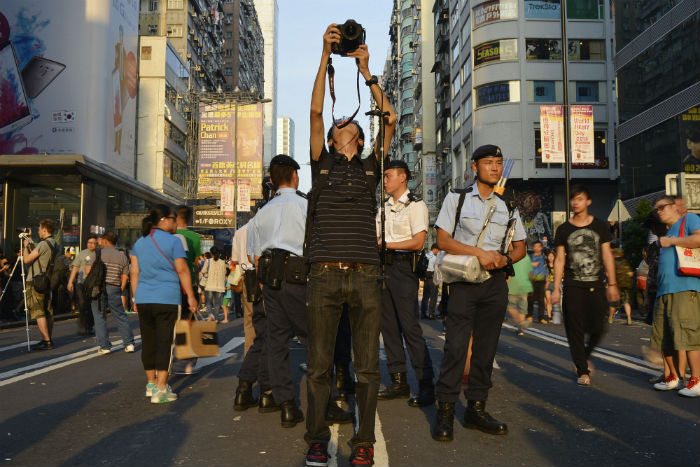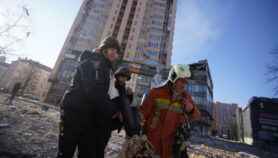By: Anita Makri
Send to a friend
The details you provide on this page will not be used to send unsolicited email, and will not be sold to a 3rd party. See privacy policy.
Programmes to counter conflict are enlisting digital tools. There are successes, and questions over lasting impact.
It’s hard to escape a sense that the world is becoming a less peaceful place. Headlines are dominated by news of protracted warfare across the Middle East and North Africa, high-profile acts of terrorism and the displacement of millions taking treacherous journeys for their lives.
But what about the evidence — is conflict really on the rise? Violence and conflict have always made headlines after all.
The latest Global peace index, which measures peace nationally and globally, confirms a trend also reported last year: that the times we live in are less peaceful than at any point in the past decade, with a growing ‘peace inequality’ gap between countries. [1] Terrorism is also at an all-time high, according to the index, and there are more displaced people than at any time in the past 60 years.
Technology plays a role here, and it cuts both ways.
“The times we live in are less peaceful than at any point in the past decade, with a growing ‘peace inequality’ gap between countries.”
Anita Makri
On the one hand it shapes modern warfare and, more recently, online spaces have become fertile ground for terrorist material such as broadcasting of sensationalist acts of violence — graphic videos by Islamic State come to mind. On the other hand, technology increasingly influences how people and organisations work to prevent conflict and build bridges.
The Spotlight collection we publish today, produced with advice from peacebuilding practitioner Helena Puig Larrauri, explores the creative uses of information and communication tools to counter conflict, as well as their promise and limitations. And it asks if technology can make a concrete and lasting impact in this field.
Rising wave of tech
An article by journalist Giorgia Scaturro presents an overview that begins with how information and communications technology (ICT) has led the rising wave of technological innovations against conflict. It sets out the main functions of tech for peacebuilding — to share information for early warning and to disrupt conversations that incite hate — with plenty of examples that testify to technology’s potential and power to build peace.
Scaturro presents a rich set of facts and figures, and ends with a look at technologies of the future — from apps to encourage cultural dialogue, to immersive virtual reality experiences through which users come face to face with ideas of enemy and empathy.
She also talks to Dan Marsh, head of technology at the NGO International Alert, about the many opportunities the organisation is pursuing to improve the knowledge base that informs peacebuilding projects.
But what about impact? The article charts several obstacles. And there are persistent questions over the long-term viability of this type of ‘digital activism’.
So are new technologies making a real difference for peacebuilding? We put the question to two leaders in the field, who offer contrasting views.
Anahi Ayala Iacucci, humanitarian director at media NGO Internews, challenges the view that technology can shape the future of peacebuilding, highlighting its limitations and arguing that the focus on it is misplaced.
Shamil Idriss, president of peacebuilding organisation Search for Common Ground, uses the example of online education exchanges to make the case that ICTs are a powerful way to foster cross-cultural understanding and plant seeds for peace.
Human response
There is common ground in these opposing views, and it’s reflected in the message that success depends on engaging people to act. A feature article by journalist Edd Gent delves into another aspect of this: technology’s role in creating networks of professionals working on peacebuilding both locally and globally. Gent talks to practitioners who also stress the value of local expertise as well as increasing links between technologists and peacebuilders.
So let’s make sure there are fire brigades on hand, and skilled firefighters, and that people can get help when their lives are hit by trauma.
In 2015, the money spent on peacebuilding and peacekeeping was equivalent to just two per cent of the global costs of armed conflict. But the rise in global conflict is making waves across the world. Strengthening global peace and security tops the priority list in the UK Department for International Development’s strategy, while the refugee crisis has prompted the Swedish International Development Cooperation Agency to redistribute its foreign aid funds. [2]
A stronger focus on the response mechanisms and human interactions that can help tech-enabled peacebuilding go further would seem to be worthwhile target — for aid funding and for initiatives that strengthen technological capacity in the developing world. It might just help tip the balance towards the kind of world we all want to live in.
Anita Makri is opinion and special features editor at SciDev.Net. @anita_makri
This article is part of our Spotlight on Technology for peace.
References
[1] Global peace index 2016 (Institute for Economics and Peace, June 2016)
[2] UK aid: tackling global challenges in the national interest (HM Treasury and the Department for International Development, November 2015)














